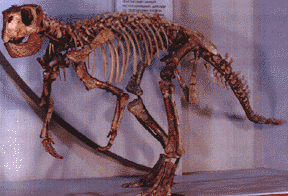
Psittacosaurus
mongoliensis -Osborn, 1923- skeleton
Archosauria: Ornithischia: Ceratopsia: Psittacosauridae
Locality:
Gobi Desert, southern Mongolia
Age: Early Cretaceous
(Aptian-Albian), 115 million years ago
Meaning of name: "parrot lizard"
Size:
a sheep
The
ceratopsids are divided into two groups: the Early Cretaceous psittacosaurids, or
parrot-beaked
dinosaurs, and the Late Cretaceous neoceratopsids, that unites two groups
of horned
dinosaurs, protoceratopsids and ceratopsids. The psittacosaurids, known only
from
the late Early Cretaceous of Central Asia, are considered to be close to an ancestor
of
the horned dinosaurs. Both the parrot-beaked and horned dinosaurs possessed jaws,
being
curved and tapered foreward and the lateral teeth highly specialized to
masticate
the vegetative food. Psittacosaurids were relatively small , up to 2 meters in
length,,
and mostly bipedal cursors although the forelimbs in these dinosaurs were
relatively
long and well-developed.
This bi-pedal dinosaur is thought to
have been a
precursor to the horned dinosaurs (ceratopsians), which include
such well-known
forms as Triceratops. The name for this dinosaur,
Psittacosaurus, means the 'parrot-lizard'
referring to its prominent parrot-like beak.
This beak was one of the principal
advances from the
fabrosaurids and hypsilophodontids which gave rise to it. Psittacosaurus
was the first step
on the path towards the four-footed, horned descendants that
were to appear more than
twenty millions years later. It had a special bone called
the rostral, found elsewhere only
in the horned dinosaurs. In many ways like the
construction of its
teeth, it is still very similar to hypsilophodonts.
Psittacosaurus
appears to be a link between two large groups of dinosaurs.
Psittacosaurus was
one of the most common dinosaurs in the Early Cretaceous collections
from Mongolia.
It sometimes makes up over 90% of all the dinosaur bones found.
Psittacosaurus
was a plant eater with leaf-shaped
teeth that sliced past one another like the
blades of scissors.
It appears to have grabbed plants with its parrotlike beak,
chopped them smaller, and then ground them up with ggastroliths (gizzard stones),
which
have been found inside some skeletons of this dinosaur.




